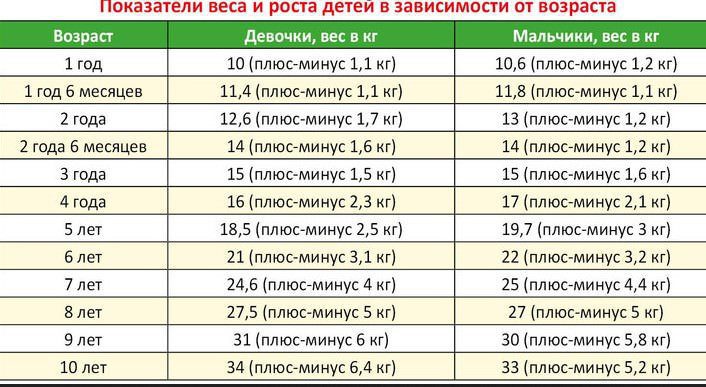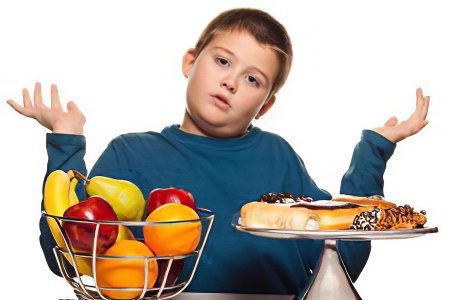Contents
The problem of overweight in children, as well as in adults, appears when energy intake exceeds its expenditure. The traditional misconception, accepted in many families, that the fullness of the baby is a sign of his health and evidence of good care for him, has brought a lot of harm to children’s health. In order to ensure that children put on weight, many parents do not follow the rules of healthy children’s nutrition.
Types and stages of childhood obesity
An indicator of children’s fullness is considered to be the thickness of the skin folds of the child, as well as the deviant ratio of weight to height. There are tables of the normal body weight of a child at each age, taking into account the gender of the children.

Deviation from the norm, expressed as a percentage, helps to establish the stage of childhood obesity:
Stage 1 – body weight deviations from the norm from 10 to 29%
Stage 2 – weight exceeds the norm from 30 to 49%;
Stage 3 – the excess is from 50 to 99%;
Stage 4 – body weight is approximately 2 times more than normal (100%).
There are two main types of childhood obesity:
alimentary – a consequence of overeating and physical inactivity;
endocrine – a consequence of metabolic disorders and diseases of the endocrine system;
neurogenic – a consequence of neuroinfections or brain tumors.
The share of alimentary obesity accounts for about 95% of all cases of this disease. Just like in adults, overweight in childhood is classified by medicine as an independent disease with serious consequences. More than half of overweight children, growing up, do not get rid of it, but acquire severe complications of their obesity.
Causes and consequences of childhood obesity
Overweight, provoked by overeating and a sedentary lifestyle, has many factors that provoke its appearance.
Causes of childhood obesity:
Hereditary modeling of eating behavior adopted in the family;
The predominance of carbohydrates, fats, high-calorie foods and dishes in the children’s diet;
Incorrectly organized feeding of infants;
Sedentary lifestyle, replacement of walks and outdoor games with watching TV and computer games, lack of physical activity;
Compensation for psychological problems of adolescence (failure, communication problems with parents and peers, inferiority complex).
Consequences of being overweight in children:
Diabetes mellitus that is not sensitive to insulin (non-insulin-dependent diabetes), when glucose cannot enter tissue cells;
Hypertension, angina pectoris, atherosclerosis, heart failure;
Chronic constipation, hemorrhoids, cholecystitis, pancreatitis;
Replacement of liver tissues with adipose tissue (hepatosis), can lead to cirrhosis of the liver;
Skeletal deformity, posture disorders, flat feet, destruction of cartilage tissue, valgus deformity of the knees (legs in the shape of the letter “X”);
Sleep disorders: respiratory arrest, snoring;
Disorder of sexual function: underdevelopment of the sex glands, delayed menarche (first menstruation), risk of future infertility;
Osteoporosis (imperfect or impaired bone formation);
Increased risk of cancer in the future;
Psychological disorders associated with eating disorders (bulimia, anorexia), drug addiction, alcoholism;
Social isolation, lack of friends, social circle, urgently needed in adolescence and youth.
The dependence of the appearance of children and adolescents on the type of obesity

For an experienced diagnostician, it will not be difficult to determine the type of obesity by the characteristic features of the child’s appearance and other symptoms. A swollen face may indicate obesity caused by hypothyroidism (lack of thyroid hormones). It is accompanied by dry skin, “bags” under the eyes, weakness, fatigue, lack of appetite, chronic constipation. In girls with this pathology, menstrual irregularities are frequent.
Thin limbs, bright pink cheeks, stretch marks on the skin of the abdomen, fat deposits on the abdomen, neck and face are signs of adrenal disease (Itsenko-Cushing’s syndrome). During puberty, girls with this disease experience increased body hair and lack of menstruation.
Short stature combined with obesity, hypothyroidism, delayed sexual development – lack of pituitary function. It is especially dangerous when these symptoms occur after neuroinfections (meningitis, encephalitis), craniocerebral injuries, brain surgeries. The lack of pituitary hormones causes a delay in puberty in young men (underdevelopment of the genital organs, lack of secondary sexual characteristics, enlargement of the gonads).
Obesity, combined with headaches, signs of increased intracranial pressure (nausea and vomiting, dizziness), may be a sign of a brain tumor. In girls, obesity in combination with acne, menstrual irregularities, increased fat content of the face and body, excessive appearance of hair on the face and body, indicates with a high degree of probability polycystic ovary syndrome.
Prevention of childhood obesity
In order to prevent negative consequences for a growing organism and not create problems in the future, you need to take care of the prevention of obesity in advance. Endocrine and neurogenic causes for the most part do not depend on the behavior and lifestyle of a person. But obesity, caused by excessive overeating and physical inactivity, is perfectly amenable to correction and prevention.
Preventive measures:
Maintain breastfeeding as long as possible;
Do not force children to finish their food or drink the contents of formula from a bottle if they have no appetite;
Do not introduce complementary foods too early;
Do not use sweeteners in the diet of preschoolers and young children;
Strictly observe the diet, do not exceed the calorie content of dishes;
Limit the amount of animal fats and easily digestible carbohydrates in the child’s diet, include more vegetable fiber, vegetables and fruits;
Monitor the dynamics of children’s weight, correct overweight in time;
Refuse fast food, sweet carbonated drinks;
To interest the child in feasible sports, spend more time with him in the fresh air.
It is very unproductive to force children to eat by force, to punish and reward with food, to manipulate the child’s behavior with favorite and unloved foods and dishes. This style of parenting can cause a psychological breakdown, lead to the appearance of pathologies of the digestive tract.
Treatment of childhood obesity

Like any other disease, obesity in children should be treated under the guidance of a specialist, without self-medication. The doctor will assess the consequences caused by obesity to the child’s body, study the anamnesis, and, if necessary, refer him for instrumental and laboratory diagnostics.
Basic treatments for obesity:
Dieting;
Dosed physical activity;
Psychological support;
Drug therapy for endocrine and neurogenic disorders.
A specialist in dietary nutrition in the treatment of childhood obesity will offer advice to the child’s parents on organizing nutrition and filling the diet. These recommendations must be followed by all family members, forming the right type of eating behavior in the family. The example of parents is the best educational method in the treatment of obesity.
Rules for children’s medical nutrition:
Eat fractionally – at least 6-7 times a day, in small portions;
Observe the diet, without deviating from the usual time of eating for more than 15-20 minutes, to form the biorhythms of the digestive processes and better digestion of food;
High-calorie foods (eggs, meat, fish) should be used in the morning;
Dairy and vegetable foods include in the menu for an afternoon snack or dinner;
Use more fresh and boiled fruits and vegetables;
Exclude from the diet fatty meats, fish, sausages, sausages, duck, goose,
Do not use nuts, bananas, persimmons, figs, raisins, dates on the menu;
The method of processing products is boiling, stewing, baking, frying up to 3 years is excluded, and then this method is used as rarely as possible.
Such a serious problem as childhood obesity requires an integrated approach to treatment, the use of a special diet, and adequate preventive measures.









